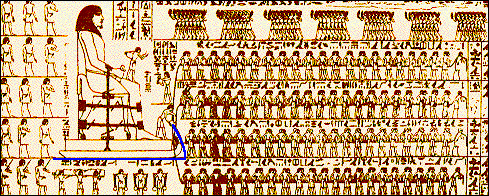| |
|
This
problem has been present from historical time. The diagram above is from the
tomb of Tehuti-Hetep in circa 1880 BCE, and shows an Egyptian statue with a weight,
W, of about 600 kN being moved by 172 men on a sled running on wooden
planks placed on the ground. To minimize the friction interaction between the
sled and the planks, water is being poured at the front end of the sled (blue
line) to form a lubricating layer. Information in the picture may be used
to estimate the friction coefficient of the wet wood surfaces. If each of
the men could pull on the ropes with a force of 800 N, their total force must
just overcome that due to friction if the sled is to move. A force, F, of 138
kN is, therefore, a maximum value for the friction interaction . Since F = mW, this estimate gives a friction
coefficient, m, of 0.23 - a good value
for wet wood! |
|
|
